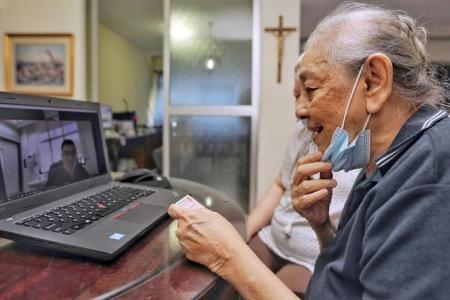Subsidised hospital care in the comfort of home from April 1
Patients who opt for hospital-level care at home will be subsidised and they can use their MediSave healthcare savings, as well as insurance payouts from MediShield Life and Integrated Shield Plans to pay for it from April 1.
This, Health Minister Ong Ye Kung said, will turn the service, called Mobile Inpatient Care @ Home (MIC@Home), into a recognised and accepted model of care in Singapore’s public healthcare institutions.
Also, to serve the medical needs of the country’s growing population, the Ministry of Health (MOH) has a new integrated general and community hospital in the pipeline for Tengah town in the west of Singapore. It will be ready in the early 2030s.
These are some of the strategies to expand the country’s healthcare capacity, said Mr Ong in his speech on his ministry’s budget on March 6.
In Singapore, what is driving up hospital bed occupancy is the increased number of seniors with complex conditions post-Covid-19, he said.
The average length of stay went up from about six days to seven days pre- and post-Covid-19, which alone represents a 15 per cent increase in patient load, he noted.
“This is happening against the backdrop of a rapidly ageing population, which compounds the problem and makes it a long-term challenge,” he said.
Three MPs, including Leader of the Opposition Pritam Singh, had raised the issue of capacity and waiting times at hospitals.
Suggestions included dynamic waiting times at hospital emergency departments and deploying more urgent care centres, which are meant for people who need urgent treatment for non-life-threatening illnesses.
Mr Ong told the House that ambulances already have a process in place to ferry patients needing urgent care to the nearest appropriate hospital for priority treatment. However, 40 per cent of cases at the emergency departments are not life-threatening or urgent.
“So our worry is that giving dynamic information may perversely drive more non-urgent cases to hospitals and worsen the overall situation,” Mr Ong said.
To help ease the bed crunch, MOH is expanding its MIC@Home pilot project – where virtual hospital beds are set up at the homes of patients, who can enjoy round-the-clock access to care delivered by a team of healthcare professionals through teleconsultations and home visits, until they are considered fit for discharge.
Having done the pilot for several months, MOH is convinced the scheme works well for the patients and has great potential to relieve the stress at hospitals, Mr Ong said.
As at end-2023, more than 2,000 have benefited from the service, translating into about 9,000 hospital bed days saved, Mr Ong revealed.
With the move to make MIC@Home a recognised and accepted part of Singapore’s public healthcare institutions, Mr Ong said patients can be assured they will not pay any more for it than they do for acute inpatient care at a public hospital.
“All our hospitals intend to price MIC@Home similar to or lower than a normal hospital ward. Patients will be supported by subsidies, MediShield Life and MediSave; no different from a physical inpatient stay,” he said.
Get The New Paper on your phone with the free TNP app. Download from the Apple App Store or Google Play Store now

